NASA APOD #983-992
#983 A Southern Sky View February 26, 1998
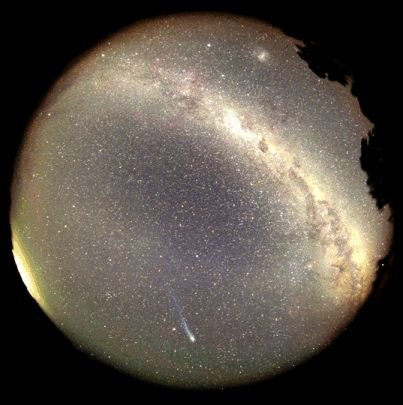
“From horizon to horizon, the night sky above Loomberah, New South Wales, Australia was photographed by astronomer Gordon Garradd on March 22, 1996. Garradd used a home made all-sky camera with a fish-eye lens, resulting in a circular 200 degree field of view. This gorgeous sky view is dominated by the luminous band of the Milky Way cut by dramatic, dark interstellar dust clouds. Along with the bright stars of our Galaxy, the Large Magellanic Cloud is visible at the upper right (about 1 o'clock) and the long, lovely, bluish tail of comet Hyakutake can be seen toward the bottom of the image, near the bright star Arcturus. Bright city lights from nearby Tamworth glow along the Northwestern horizon."
Copyright: G. Garradd
#984 Solar Eclipse: A Composite View February 27, 1998
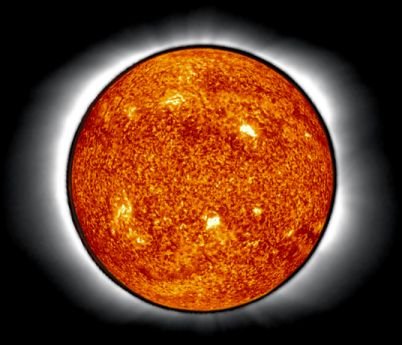
“Yesterday, the Moon's shadow reached out and touched the Earth, treating a large portion of the Western Hemisphere to an Eclipse of the Sun. This composite image combines pictures of the Sun made from both Earth and space. The central direct image of the solar surface was recorded yesterday by the Extreme Ultraviolet Imaging Telescope on board the space based SOHO observatory. It is surrounded by a telescopic picture of the Sun as seen from the island of Aruba during the total eclipse. The surrounding view of the eclipsed Sun reveals the gleaming solar corona, visible to ground based observers during totality. Such combined images can help connect explosive events and features on the Sun's surface with the corona and solar wind."
Copyright: Public domain
#985 Eagle EGGs in M16 February 28, 1998
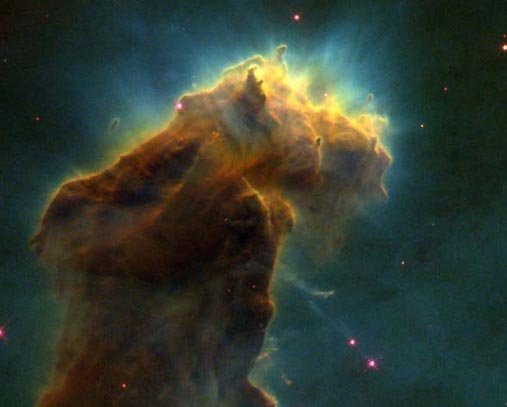
“Star forming regions known as "EGGs" are uncovered at the end of this giant pillar of gas and dust in the Eagle Nebula (M16). EGGs, short for evaporating gaseous globules, are dense regions of mostly molecular hydrogen gas that fragment and gravitationally collapse to form stars. Light from the hottest and brightest of these new stars heats the end of the pillar and causes further evaporation of gas - revealing yet more EGGs and more young stars. This picture was taken by the Wide Field and Planetary Camera on board the Hubble Space Telescope."
Copyright: Public domain
#986 A Sky Full Of Hydrogen March 01, 1998
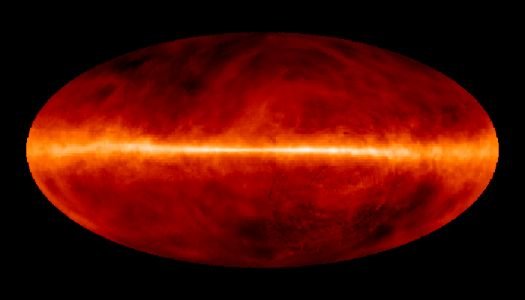
“Interstellar space is filled with extremely tenuous clouds of gas which are mostly Hydrogen. The neutral hydrogen atom (HI in astronomer's shorthand) consists of 1 proton and 1 electron. The proton and electron spin like tops but can have only two orientations; spin axes parallel or anti-parallel. It is a rare event for Hydrogen atoms in the interstellar medium to switch from the parallel to the anti-parallel configuration, but when they do they emit radio waves with a wavelength of 21 centimeters (about 8 inches) and a corresponding frequency of exactly 1420 MHz. Tuned to this frequency radio telescopes have mapped the neutral Hydrogen in the sky. The above image represents such an all-sky HI survey with the plane of our Milky Way Galaxy running horizontally through the center. In this false color image no stars are visible, just diffuse clouds of gas tens to hundreds of light years across which cluster near the plane. The gas clouds seem to form arching, looping structures, stirred up by stellar activity in the galactic disk."
Copyright: Public domain
#987 Rumors of a Strange Universe March 02, 1998
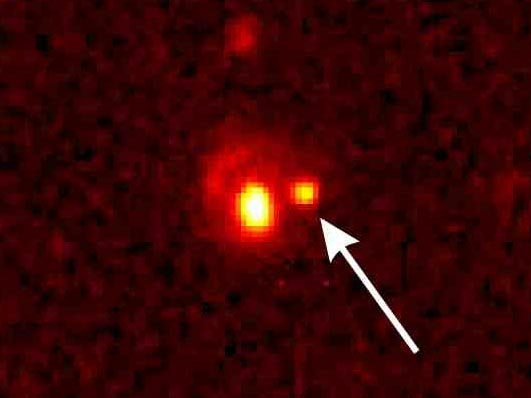
“In a meeting in California two weeks ago, unpublished results were presented indicating that most of the energy in our universe is not in stars or galaxies but is tied to space itself. In the language of cosmologists, a large cosmological constant is directly implied by new distant supernovae observations. Suggestions of a cosmological constant (lambda) are not new -- they have existed since the advent of modern relativistic cosmology. Such claims are not usually popular with astronomers, though, because lambda is so unlike known universe components, because lambda's value appears limited by observations, and because less-strange cosmologies without lambda have historically done well in explaining the data. Therefore most lamdba claims do not make the News Summary in a prestigious journal like Science. What is noteworthy here is the seemingly direct and reliable method of the observations, and the good reputations of the scientists conducting the investigation. The above picture of a supernova at redshift 0.5 in a spiral galaxy, was taken by this collaboration. However, two teams of scientists are independently studying distant supernovae, and the last official word from the other team was a result consistent with no cosmological constant, reported just two months ago. Extraordinary claims require extraordinary evidence, and so cosmologists the world over eagerly await peer-reviewed results, further details, and more data."
Copyright: Public domain
#988 560 Kilometers Above Europa March 03, 1998
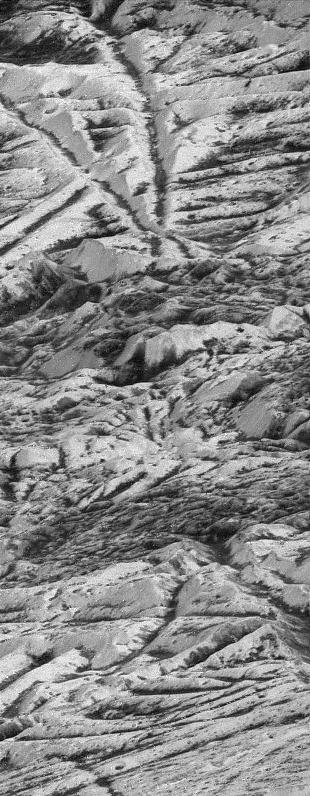
“Tomorrow's picture: Aurora Over Alaska < Archive | Index | Search | Calendar | Glossary | Education | About APOD > Authors & editors: Robert Nemiroff (MTU) & Jerry Bonnell (USRA) NASA Technical Rep.: Jay Norris. Specific rights apply. A service of: LHEA at NASA/ GSFC &: Michigan Tech. U."
Copyright: Public domain
#989 Aurora Over Alaska March 04, 1998
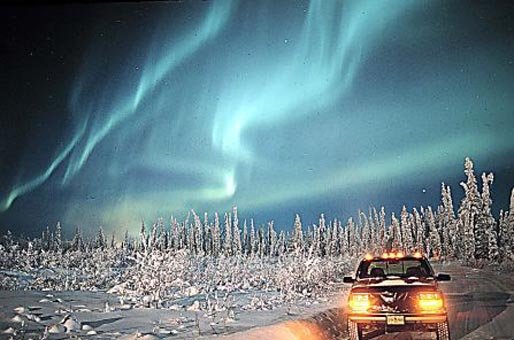
“Higher than the highest mountain, higher than the highest airplane, lies the realm of the aurora. Aurora rarely reach below 60 kilometers, and can range up to 1000 kilometers. Aurora light results from solar electrons and protons striking molecules in the Earth's atmosphere. Frequently, when viewed from space, a complete aurora will appear as a circle around one of the Earth's magnetic poles. The above photograph was taken in January in Alaska and shows a spectacular aurora borealis above a frozen landscape which includes spruce trees and the photographer's truck. The picture had to be taken quickly as the temperature was below -40 degrees."
Copyright: D. Hutchinson
#990 Canaries Sky March 05, 1998
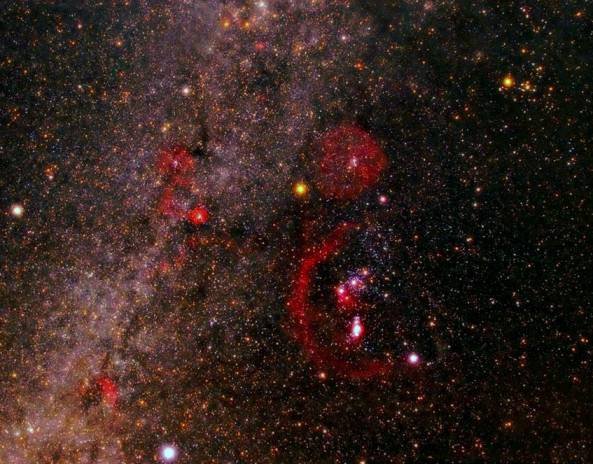
“This gorgeous view of stars, nebulae, and the Milky Way comes from the dark night sky above the lovely island of La Palma in the Canaries archipelago. The picture was made by a group of experienced astrophotographers who traveled there to take advantage of the ideal observing conditions near La Palma's Observatorio del Roque de los Muchachos. Skygazers can easily pick out several of their favorite astronomical objects in this wide angle time exposure which covers about 40 degrees on winter the sky. Faint stars along the plane of our Galaxy compose the delicate, luminous band of the Milky Way stretching across the image from the bottom left. The familiar constellation of Orion the hunter is also easy to find, with glowing nebulae highlighting the hunter's belt and sword. Orion's famous red giant star Betelgeuse, near picture center, has a yellowish cast and Rigel is the bright star in Orion at lower right. Brilliant white Sirius, near the bottom, is the brightest star in the picture (and in Earth's night sky). Sirius, is part of the constellation Canis Major (Big Dog). Across the Milky Way, above and to the left of Sirius, is slightly less brilliant Procyon, brightest star of Canis Minor. A V-shaped group of yellowish stars at the upper right, part of Taurus the bull, is dominated by the red giant Aldebaran."
Copyright: A. VanniniG. Li CausiA. RicciardiA. Garatti
#991 Water Ice At The Lunar Poles March 06, 1998
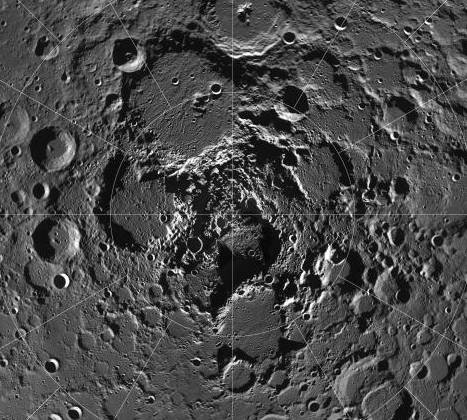
“After seven weeks in lunar orbit, instruments on board NASA's Lunar Prospector spacecraft have produced strong evidence for water ice on the Moon. While not in extensive sheets, this ice could be in the form of crystals, mixed in low concentrations with material in craters around the frigid North and South lunar poles. How much ice? So far, the estimates are from 10 to 300 million metric tons (about 3 to 90 billion gallons). The water ice is likely a result of meteoritic and cometary bombardment. Using very different instruments, the Star-Wars-technology Clementine spacecraft also detected telltale signs of ice as it orbited the Moon in 1994. Although the lunar samples returned by the Apollo missions suggested that the Moon was bone dry, the Clementine result sparked the controversy and hope that water ice might still be found - holding out the tantalizing possibility that a substantial reservoir of lunar water could be used to support human exploration. Above is a mosaic of Clementine images of the cratered terrain surrounding the Moon's North pole. Surprisingly, Lunar Prospector's data indicates that the North polar region contains about twice as much ice as the South. As Lunar Prospector's mission continues, further data will help determine more precisely the amount and distribution of the water ice."
Copyright: Public domain
#992 NGC 1818: A Young Globular Cluster March 07, 1998
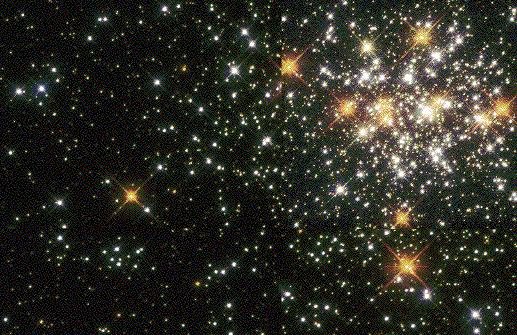
“Globular clusters once ruled the Milky Way. Back in the old days, back when our Galaxy first formed, perhaps thousands of globular clusters roamed our Galaxy. Today, there are perhaps 200 left. Many globular clusters were destroyed over the eons by repeated fateful encounters with each other or the Galactic center. Surviving relics are older than any earth fossil, older than any other structures in our Galaxy, and limit the universe itself in raw age. There are few, if any, young globular clusters in our Milky Way Galaxy because conditions are not ripe for more to form. But things are different next door - in the neighboring LMC galaxy. Pictured above is a "young" globular cluster residing there: NGC 1818. Recent observations show it formed only about 40 million years ago - just yesterday compared to the 12 billion year ages of globular clusters in our own Milky Way"
Copyright: Public domain
Upvote! Resteem! Comment! As you like it! Thank you for attention!